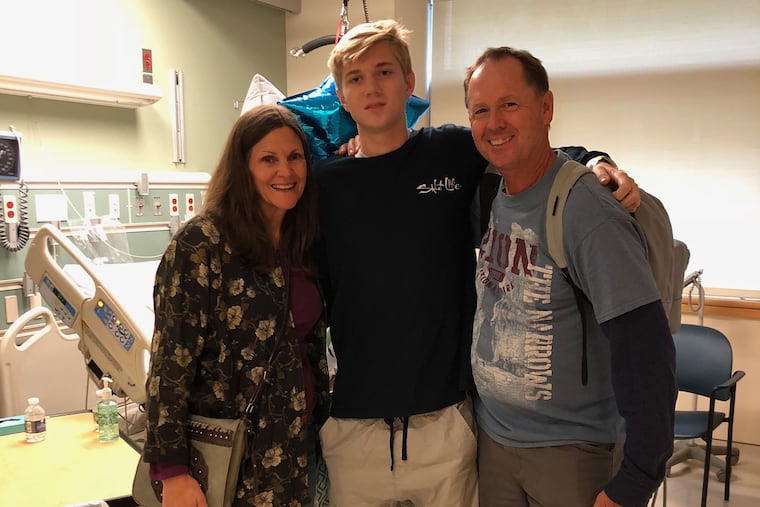Medical mystery: A Penn State student’s massive blood clot surprised even his doctors
An ultrasound and found that the man had clots from his navel down to his legs. Doctors used tissue plasminogen activator to break up the clots but they returned within minutes.

Zachary Reigel, a sophomore at Pennsylvania State University, was playing a pickup game of basketball with friends at the Intramural Building on campus in August when his legs suddenly went numb.
After being helped off the court, the 19-year-old architectural engineering student began to feel nauseated and collapsed onto a bench before he could get to the restroom. When friends found him about 20 minutes later, his legs were swollen and purple and his lower back hurt. They called for an ambulance.
At Mount Nittany Medical Center, emergency room doctors could not find the cause of Reigel’s pain or swelling. They prescribed medication and sent him home with a referral to see an orthopedist for his back pain.
This was not the first time Reigel, of Downingtown, had suffered from nausea when playing basketball.
While in high school, he was referred to specialists when his symptoms continued long after the game stopped. When nothing could be found to account for his nausea, one doctor suggested taking over-the-counter medication for motion sickness. That seemed to do the trick.
Back in his off-campus apartment, Reigel was still unable to move about comfortably. At his follow-up appointment with the orthopedist, the doctor took one look at Reigel’s still swollen legs and immediately sent him to a vascular surgeon.
Reigel was admitted to Mount Nittany Medical Center, where doctors made a startling discovery. He was missing a major vein.
The inferior vena cava (IVC) is a large vein that carries deoxygenated blood from the lower body — the legs and abdomen — to the heart, which then pumps oxygen-rich blood to the lungs.
During fetal development, if the IVC fails to mature, the azygos vein, which runs up the spinal column, can take over and help with drainage. A missing IVC occurs in less than 1 percent of the population and unless there are problems, such as developing a deep-vein thrombosis, the problem may never be diagnosed.
In patients without an IVC, there is blood supply to the leg but no drainage. Those who suffer symptoms are usually put on blood thinners, told to wear compression socks, and sent home to live with what can become a debilitating condition. Others may undergo an invasive surgery to try to correct the condition.
“We were amazed that he had survived 19 years without the main vein going back to his heart,” said Nancy Reigel, his mother.
At first, doctors thought the missing IVC might be related to hereditary hemorrhagic telangiectasia (HHT), which Zachary Reigel was diagnosed with at age 7, she said.
HHT is an inherited disorder in which blood vessels do not develop normally. The condition can result in arteriovenous malformations (AVM) in the brain that carry the risk of bleeding or seizures. Reigel, who was tested after his paternal grandfather was found to have the disorder, had no symptoms and was being monitored once a year for the condition at the Hospital of the University of Pennsylvania (HUP).
The vascular surgeon at Mount Nittany Medical Center performed an ultrasound and found that he had clots from his navel down to his legs. They used tissue plasminogen activator (tPA) to break up the clots and he was released from the hospital within a couple of days.
But at his checkup two days later, the clots had returned, Nancy Reigel said.
She contacted doctors at HUP and was referred to Deepak Sudheendra, 44, an interventional radiologist. That night, her son was transferred to Philadelphia by ambulance.
“That was a miserable ride,” he said, recalling how much pain he was in.
Solution
Reigel’s diagnosis was so rare that it was “like a zebra," said Sudheendra, using medical slang for an exotic diagnosis.
Sudheendra repeated the tPA injections. The clots dissolved, then reappeared within five minutes.
Sudheendra said Reigel could not go home on tPA. They reinserted catheters to drip the clot buster into his veins overnight and got to work researching options.
“I really didn’t find much,” Sudheendra said about his research. He went back to look at the CT scans and fortunately found a remnant of Reigel’s IVC.
Sudheendra came up with a plan to reconstruct the IVC by threading a 0.035-inch diameter guide wire (thinner than a piece of angel hair pasta) into incisions in Reigel’s groin and neck, where they would meet up near his heart at the remnants of the IVC. They then would use angioplasty balloons ranging from 4 to 28 millimeters to open the IVC and put in stents.
It took the interventional radiology team, including nurses and anesthesiologists, eight hours to complete the successful procedure, Sudheendra said.
Reigel was discharged from the hospital after a few days. He took a semester off to recover, gained back the 20 pounds he lost during the ordeal, and returned to campus in January. He is even back to playing pickup basketball. He will need to be monitored once a year and take blood thinners for the rest of his life, he said.
“Honestly, it didn’t hit [me] until I was a month out of the hospital that I just went through a lot of stuff,” said Reigel. “In the moment you don’t realize how lucky you are.”
Sudheendra presented Reigel’s case at a recent medical conference in Las Vegas. He has been contacted by several patients across the country for help with similar conditions.
Because the procedure is new there is no way to know what the long-term outcome is for Reigel but Sudheendra is hopeful.
“I think he will live a normal life,” said Sudheendra.